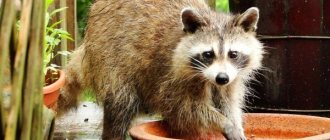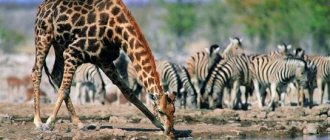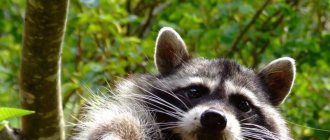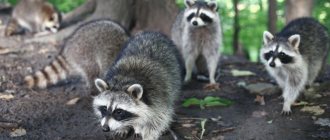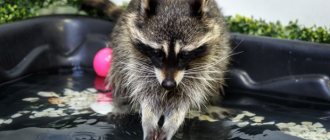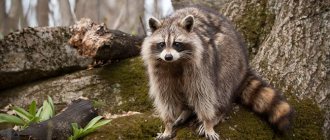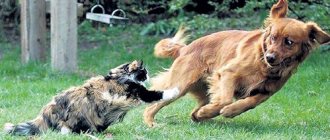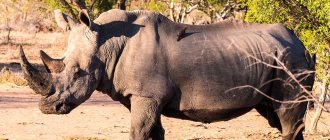— Why were you late for the meeting of the Stupid Excuses Club? - You see, a raccoon swallowed my keys, and... - Don’t continue, it sounds convincing, go ahead.
Have you ever thought about getting yourself a pet raccoon? It’s good if you haven’t done this, after reading the article the desire will definitely not arise. It’s better to get a cat or a bird, but under no circumstances a raccoon, it will make your life unbearable!
More and more people want to have a raccoon as a pet. If raccoons are raised from childhood, they make good pets that get along well with humans. Raccoons are very curious and active and require the most careful supervision, otherwise they can get into trouble or cause trouble to others. But despite this, raccoons are so adorable!
Let's find out about his life in the wild and at home.
The animal raccoon can compete with human hands in the agility of its forelimbs - its actions are so dexterous and precise. With its front paws, a raccoon is able to grab any objects, including food, as well as confidently hold them and even wash them. In this, the raccoon’s action is somewhat reminiscent of gargling, which is why one of its varieties received the name “gargle.”
What does a raccoon look like?
A raccoon is very easy to recognize by its dark “mask” around its eyes and the same dark transverse lines on its tail. The body of the raccoon is very dense, stocky, the paws are short, the fur is fluffy and long, grayish-brown in color, the tail is the same tone, very fluffy. The raccoon has rounded ears and a wide head, which gradually turns into a thin, narrow and quite cute muzzle, decorated with a black “mask” with a light fur trim, somewhat reminiscent of sideburns. There is a dark brown spot around the raccoon’s eyes, and a stripe of the same shade runs from the tip of the nose to the forehead. A raccoon's tail usually has 5 to 7 wide black rings.
Remember:
- Always follow the rules for interacting with raccoons. This way you can minimize possible injuries from fangs and claws.
- No healthy animal will bite “just like that.” Perhaps the raccoon bit you because you scared it, or it was acting out, or you wanted to take something away from it.
- Domestic raccoons control the force of their bite. That’s right, even if you were bitten by a raccoon, think that a wild raccoon bites many times harder. Moreover, there is a possibility that he has rabies, for example.
Where do raccoons live
The raccoon is a typical inhabitant of North and Central America , where it is extremely widespread to this day, occupying not only wet places (its usual habitat areas), but also suburban areas. In the 20th century, this valuable fur animal was brought to one of the European countries - Germany, from where it began its “conquest” of the rest of Europe. Today, the largest concentration of raccoons is in the Netherlands and France, where they have acclimatized well. Then the raccoons were transported further east, and now raccoons can be found in Belarus, Kyrgyzstan, Azerbaijan, Dagestan, the North Caucasus, the Far East, the Krasnodar Territory and even on the islands of the West Indies.
Raccoon goes on the warpath
You need to be extremely careful with wild raccoons. These creatures are very touchy. Without responding with affection to the playful manners of this bully with a striped tail, the raccoon can take revenge. He does this competently and with great pleasure. So, why is a raccoon dangerous to humans?
1. Hide everything that can be ruined. A raccoon with hurt feelings can damage garden furniture, tear to shreds clothes and shoes hung out to dry, and scratch the rubber on car, motorcycle, and bicycle tires to holes. There is no limit to the ingenuity of raccoons. He will slowly push your things on a daily basis. Slowly but surely cause minor mechanical damage to material assets, which renders things unusable. Believe me, a wild raccoon is very dangerous to humans.
2. Keep an eye on your pets. It can get to the point that the raccoon will take out its revenge on its pets. Raccoons are true masters of intimidation and virtuosos of physical influence on opponents. There are frequent cases when a domestic cat or dog begins to behave strangely. They suddenly become fearful and can behave defiantly inappropriately. This is the work of a raccoon. It can harm pets by teasing them, driving them to despair and taking away food. Do raccoons bite? – Yes, these striped-tailed hooligans often get into fights with dogs and cats using their powerful fangs.
3. Lock doors and windows. It’s not for nothing that the raccoons received a bandit mask on their face. These sneaky guys are professional burglars. There are frequent cases when a raccoon “ruins” the kitchen of a private house, and the owners don’t even know about what happened, blaming their pet (cat or dog).
A fresh story recently appeared in the press about how raccoons are still dangerous. One cunning man got into the ventilation duct of a multi-story residential building, chewed through the fan wiring there, which subsequently caused a big fire. The house, worth $1.5 million, burned to the ground.
Related material: Is it possible to tame a raccoon?
In addition, law enforcement officers often receive reports that charming hooligans with striped tails sneak under people’s blankets in the middle of the night. Yes, yes, you heard right. A wild raccoon can slip through some window crack, open the door to the bedroom and, as if nothing had happened, dive into a calmly dozing person under a warm blanket.
Are raccoons dangerous to humans? Risks of contact with a wild raccoon
1. Rabies. Feral raccoons carry rabies and tetanus. An infected animal, in a fit of blind rage, can cause not only damage to property, but also serious physical injury to a person. I don’t want to scare readers, but the consequences of a human encounter with a wild and rabid raccoon can be terrifying.
It’s okay if on the raccoon’s path he meets an adult and physically strong person who can fight back a feral bully. What if a rabid raccoon attacks a child? This is the main thing why a raccoon is dangerous to humans.
2. Infectious excrement. If we are talking about domestic raccoons that receive various vaccines and antihistamine treatments, then the result of the natural needs of raccoons is not terrible. Another thing is wild raccoon excrement. Contact with them is strictly prohibited. The excrement of a wild raccoon is simply teeming with very dangerous parasites (roundworms and giardia). In this case, the raccoon is dangerous for humans, and even very dangerous.
Very often, domestic animals become victims of this threat, and through them humans become infected. Treatment for these parasites is quite labor-intensive and expensive. You can pay several hundred American dollars for therapy for one animal.
3. Crop theft. Raccoons carefully and with gusto surround household plots. Peaches, plums, grapes, apples, strawberries, pears, nuts, pumpkins and zucchini. Raccoons love berries, fruits and vegetables with nuts. Owners of private houses tirelessly complain that they are being robbed by charming sly men in masks. Having waited until nightfall, the raccoons enter the territory of the estate as if it were their own home and begin to run the show there in full. These masked sneaks don't stop even in front of angry dogs. There are cases when a trained dog runs away with its tail between its legs from an angry raccoon (or from a pack of raccoons). Do raccoons bite? - Yes, these hooligans can really bite the poor dog.
Raccoon habitats
The animal raccoon is mainly an inhabitant of wet places , therefore it always settles near fresh water bodies, from which it gets its food. In the wild, as a rule, this is:
- rivers;
- swamp;
- ponds;
- lakes.
The raccoon does not neglect places near populated areas , since the proximity of human habitation does not bother the raccoon at all - on the contrary, it often visits farms in search of food. In general, the raccoon animal easily adapts to any conditions, populating the outskirts of gardens and fields, forest plantations, squares and abandoned empty buildings. It can also live in attics, basements, and unused chimneys and drainpipes. It loves hollows, where it mainly settles, preferring old trees in mixed forests. It is installed 20-30 meters from ground level. It also inhabits rock crevices and abandoned burrows. The raccoon does this forcedly because it is not able to dig the ground. Spends most of the daytime in trees.
Raccoon connection.
Raccoons are very social animals. In nature, they live in communities of 5, 6 or even 10 individuals. Therefore, it is important for any raccoon to be able to communicate. Namely, to be heard in your desires, preferences, hobbies, mood, and so on. First, realize that the raccoon will not serve you or protect your home. The main task of a raccoon is to be a raccoon.
Raccoons build relationships based on personal preferences. If a raccoon doesn't like someone, it's difficult to convince him otherwise. Your task is to please the raccoon from its very childhood, so that it perceives you either as a mother or as a brother - an equal to itself.
The strongest and most unique bond with a raccoon occurs when you take the baby when it is very tiny and hand-feed it. In this case, the raccoon automatically considers you a relative and becomes part of your community. Raccoons are good at feeling the mood of their fellow tribesmen and it will be much easier for you to find a common language. The raccoon will think that you are a raccoon too, just a little weird.
Another connection is conditionally brother-sister. In such a relationship, the raccoon can afford a little more. He will always try to “pull the blanket” and try to dominate. This option is not bad if you are willing to let the raccoon bite you and bite the raccoon back.
Habits of raccoons
The raccoon is a nocturnal animal . During the day he sleeps and at night he goes out in search of food. It does not move far from the home, preferring a distance within a radius of one and a half kilometers. It has excellent ability to see in complete darkness. This provides him with not only well-developed night vision, but also vibrissae, tufts that the raccoon has on the head, on the stomach, on the chest, and on the inside of the limbs, near the claws. Raccoons are also not afraid of water and can swim well.
Before putting food in its mouth, a raccoon always rinses it in water first. Scientists attribute this rather not to the hygienic requirements of the animal, but to curiosity: its actions serve to better study its prey. In general, the animal grabs with its fingers everything it encounters on its way.
In northern regions, raccoons hibernate in winter , staying in their burrows for weeks until severe sub-zero temperatures, snowfalls and cold winds subside. At such times, their metabolism slows down, their heart rate and body temperature drop (but only slightly). For example, in the Canadian zone, raccoon hibernation can last up to 4 months, and in regions with a warmer climate - several weeks. Animals occupying the southern parts of the range are active year-round.
The owner of the social media star raccoon Ilyusha betrayed his accomplice in the destruction
The appearance of a raccoon is deceptive: the cutest fellow with a charming face, touching paws and arms and a thick butt is not as harmless as it might seem at first glance. And if these animals form a gang and enter the house, expect a pogrom!
– “Who wants to get a raccoon? Nobody else wants it? I'll give you a few of mine. Ilyusha! Get out, my snaggle-toothed crap! I’ll kill you now!” – few people in your place could contain their emotions. But there were people who saw animal cruelty in the video, even though you didn’t lay a finger on the raccoon!
– Yes, this video was immediately blocked on Instagram, but many had already downloaded it, including stars Lera Kudryavtseva and Gosha Kutsenko. I have new subscribers. They also brought a three-month-old raccoon, which was abused by dogs, and now I am nursing it,” says Elena Malinina.
In the courtyard of her house there is a shelter for animals that find themselves in difficult situations: abandoned, lost, injured. Elena cares for more than 60 dogs, about 30 cats, four raccoons and a nose. It is difficult to feed such a horde on a chef's modest salary. Therefore, the strong support of subscribers came in handy.
“I nurse animals, rescue them, and then look for a new home for them,” says Elena. - But I won’t give the alabayka to anyone. I found her in the fall and with difficulty pulled her out of severe stress.
And Ilyusha has been living with me for five years. He is a foundling. By the way, Ilyusha was not the only one who destroyed the house. When I entered the bedroom, I saw Nyusha first, but she quickly jumped out the window.
-What picture did you find in the house that very day?
“At first I thought I was robbed!” Shoes are scattered, everything is turned upside down. I was surprised: what can you look for from me? And you can’t easily get through 30 dogs in the front yard and the same number in the back yard!
Then I caught my raccoons in the act, and everything became clear. Nyusha hunted me for two months - she wanted to bite me! She did not succeed - she decided to destroy the hut in revenge.
I was scared for the cat that lives in the house. Ilyusha is friends with cats, but Nyusha can tear them to death. When a rustling sound came from behind the washing machine, I was glad that the cat was alive. But from there a raccoon's face appeared. Fortunately, the cat hid behind the bed, and Nyusha could not get in there.
-How did the raccoons get into the house?
– I have a small frame house on stilts, only 45 square meters. And the raccoons have a spacious enclosure with a 24-meter canopy. They feel comfortable there: ladders, houses, a running wheel. That morning, the raccoons became noisy, I barked at them from the bedroom window, which is located directly above the canopy, and, apparently, did not close it completely. They most likely climbed onto the roof of the enclosure and slipped into the house.
– Did you cause a lot of damage?
- Everything was smashed to smithereens! The dishes were smashed, the multicooker was damaged, the electric stove was thrown off, the kettle was broken, the flowers were turned over and earth was smeared on the walls. We started with the bedroom: we tore off the MDF panels. It's strange that the TV survived. We had fun for three hours. I spent the whole night putting things in order, because I was expecting my father to visit from Stavropol. He would say: “I’ve created a zoo here!”
– Do you categorically advise against taking a raccoon into your home?
– I have a special feeling for raccoons, I love them very much, but I don’t understand people who keep a raccoon at home. This wild animal cannot be trained.
Nyusha and I, when she was little, sometimes walked in the city. One day she started climbing around the flowerbed. I pulled her out of there, and she tore my hands bloody. People keep raccoons, which then suffer.
Recently a call: “Take the raccoon! He is only friends with the cat and does not let people near him. Doesn't sit on hands. You can't make a video with him. Take it, or tomorrow we’ll throw it in the trash along with your dowry!”
Or a veterinarian I know says: “They brought a three-month-old raccoon and asked him to remove all his teeth so that he wouldn’t harm small children while playing!” The doctor kicked them out and also warned her colleagues not to let them enter the door.
– Elena, you are a cook by profession. Do you sometimes spoil your favorite raccoons?
– Raccoons eat fruits, eggs, and berries for breakfast. For dinner they have buckwheat or rice with chicken or fish. And I cook different dishes for my relatives. I used to have a cafe in the South Market. To this day, clients call and can’t forget my homemade shawarma!
– Will there be new videos with Ilyusha?
– At the request of subscribers, I’ll take him out for a walk on the weekend. I already bought a harness and leash.
What do raccoons eat
Raccoons are not picky about food, so they consume everything: • insects; • frogs; • small rodents; • walnuts; • apples; • various berries; • acorns; • eggs; • arthropods; • birds; • crustaceans; • fish, etc.
Adult raccoons are especially omnivorous. However, their most traditional foods are grains, fruits and fish. Living within the reach of human habitation, raccoons also rummage through garbage cans and landfills - their dexterous fingers on their front paws easily remove lids from any containers. It happens that adult animals sometimes raid chicken coops and farmland.
Reproduction and offspring
With the onset of spring, when raccoons wake up after winter, their breeding season begins. During this period, animals are actively looking for sexual partners. Males learn that the female is ready to mate by secreting a special secretion. After mating, males leave the fertilized females and go in search of new females. As a rule, males always live alone, so they do not take any part in raising the young after they are born.
After fertilization, females begin to bear their future offspring for 2 months. At the same time, at the end of the pregnancy period they behave quite aggressively and unpredictably. The babies born are both blind and deaf, and they weigh no more than 75 grams. After 3 weeks they begin to see and hear. During this period, the female feeds them exclusively with her milk, and only after the juveniles have milk teeth, solid food begins to appear in their diet. The female feeds her cubs literally every hour.
Important point! Just in case, the female prepares several shelters for herself, so in case of danger, she quickly moves the entire brood to another hole. This allows you to save all future offspring from death.
Every year up to 5 cubs are born. The coat of small raccoons begins to actively grow from the first days of life, and a characteristic “mask” immediately begins to appear on the face.
The female communicates with her cubs through special sounds, which include whistling, soft purring and grumbling, as well as a piercing cry. It should be noted that adult animals do not communicate with each other so often and not so loudly.
three dimensional space
The raccoon has whisker hairs all over its body and an extremely developed sense of touch. He needs a varied landscape. Earth, foliage, pebbles, boulders, branches, roots, stumps. Uniform laminate flooring and smooth walls make the raccoon sad. Which leads to a strong desire to gut something, chew it, scatter it.
Raccoons love heights. Dogs run on the surface. Cats climb into low birdhouses. Raccoons often sleep in treetops. Denying access to an overhead view is a severe blow to their familiar environment.
In addition, raccoons need to go to sleep for the winter. Otherwise, metabolic disorders are quite possible. To sleep, you need a secluded room where it’s not just cool – it’s frosty.
Solution
Taking into account the situation, this year at a meeting of the scientific and technical council of the Sochi National Park, a decision was approved on the need to regulate the number of raccoons. It is also recommended to open amateur sport hunting on the territory of the national park. Applications have already been completed and sent to the relevant department of the Ministry of Natural Resources.
Revaz Pruidze, head of the wildlife protection department of Sochi National Park:
— Two years ago, representatives of the Sochi City Hunters Society approached the management of the Sochi National Park with a proposal to open
amateur sport
hunting for raccoon.
In the 2016-2017 season, hunting was allowed, but in the form of a trial mode. Then 25 hunters expressed a desire to obtain permission. Of course, these measures can affect the current situation and reduce the number of American raccoons. But this requires appropriate permits and time. In the meantime, citizens should remember the need to comply with safety measures.
Farmers are recommended to arrange the territory of their private farms in such a way that poultry houses and other outbuildings are covered on all sides with a metal mesh.
The recommendation for owners of tamed raccoons is to sterilize their pets and give them the necessary vaccinations.
All other residents and guests of the resort should be careful: if you see a raccoon on the street, do not approach it or feed it. We must remember that the animal is dangerous, and meeting it can result in a real threat to health and even life.
We also remind you that taking measures to eliminate wild animals on your own is strictly prohibited by law. Violators may face liability under Art. 258 of the Criminal Code of the Russian Federation (Illegal hunting).
So here it is
Before getting a raccoon, think about whether you have:
- qualification of a zoologist-specialist in small mammals;
- sufficient and fenced area on all sides with trees and varied landscape;
- a secluded and equipped place for winter sleep;
- the ability to provide a varied diet in the right doses;
- constant access to a veterinarian.
If at least one answer is negative, then we do not recommend it. Take the Maine Coon, the largest domestic cat. Previously it was considered a cross between a cat and a raccoon. Smart, playful, loyal and easy to train. Don't bring a wild predator into your home.
Liked? Want to stay updated? Subscribe to our Twitter, Facebook page or Telegram channel.
